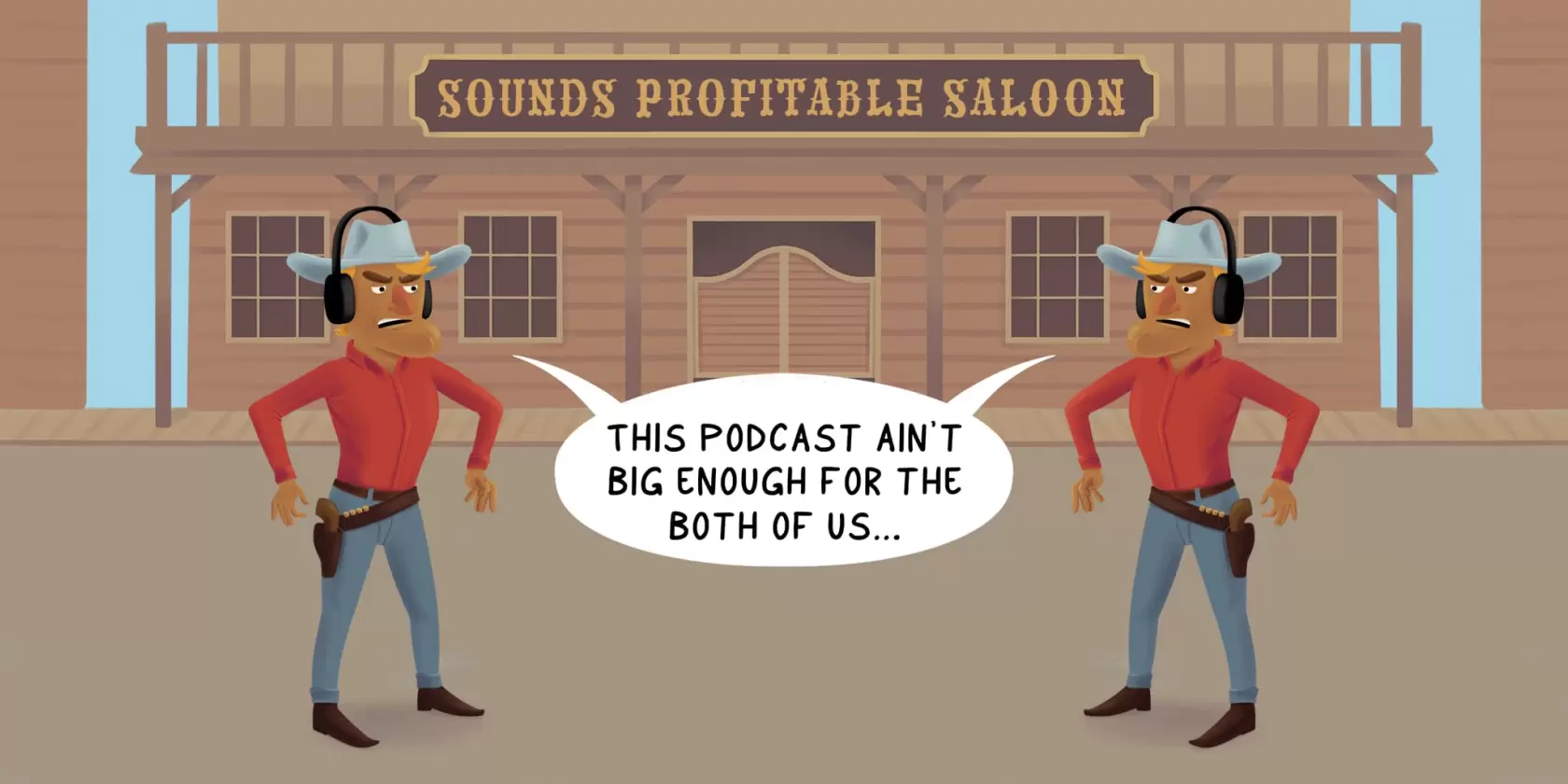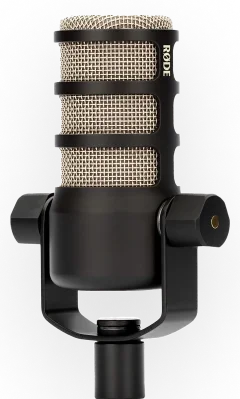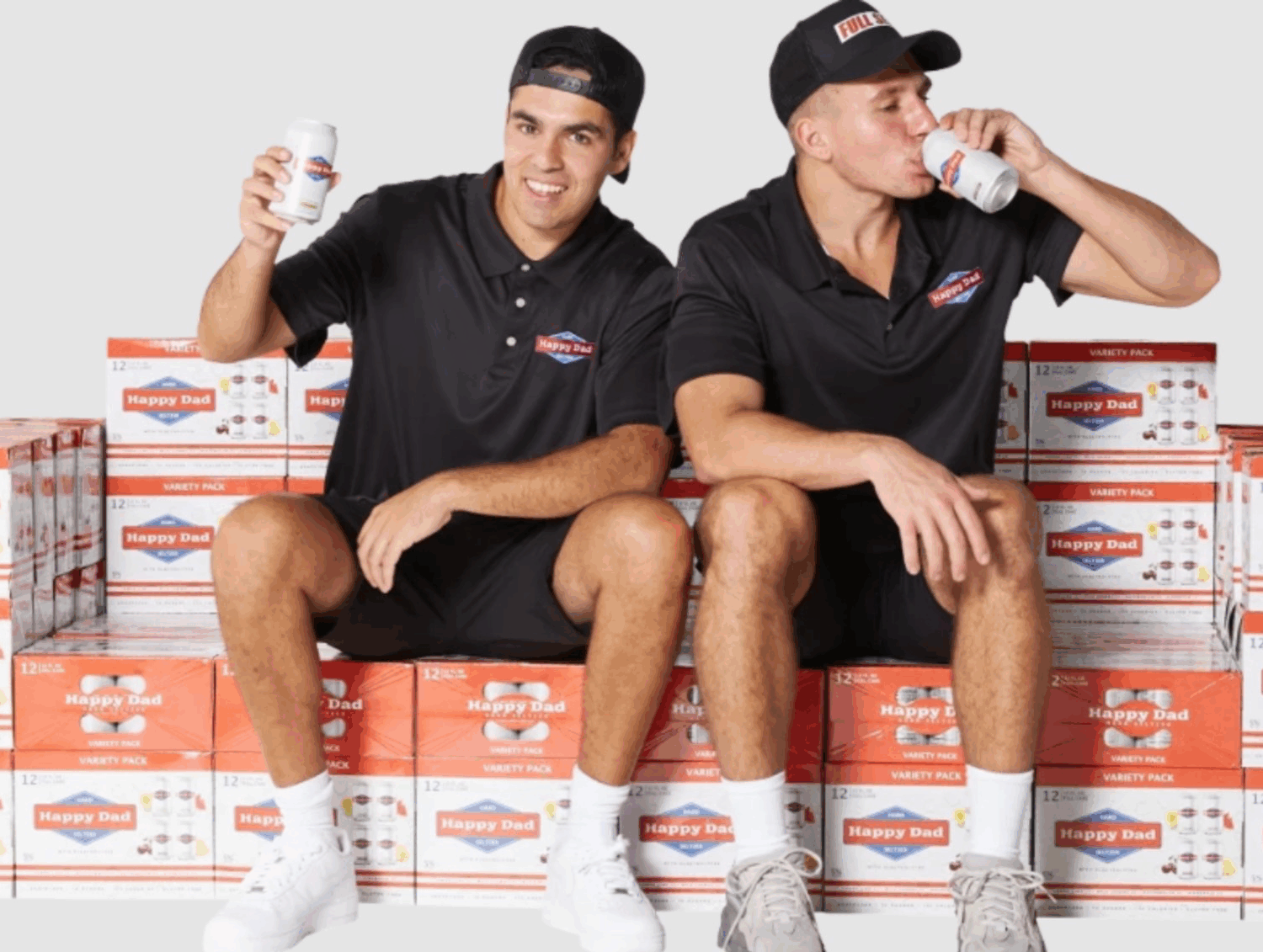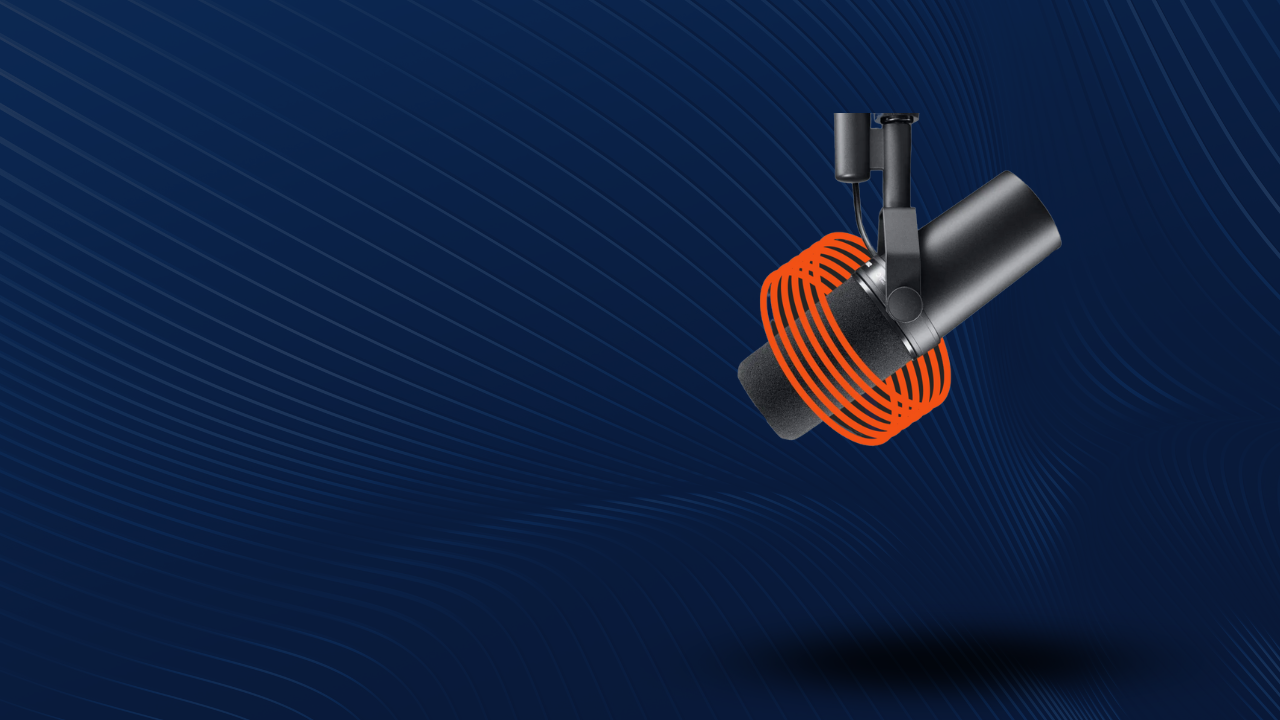We’ll Be Right Back, the latest research study from Sounds Profitable, is available now! Check out the companion piece to August’s study After These Messages for more data on demographics, messaging, branding, and even the use of promo codes. Available for download now.
With Tom onboard, I’ve recently found myself with a strong urge to investigate things I keep hearing repeated in the podcast industry that just don’t sit right with me. One of them is that we have a major frequency capping issue.
So a few weeks back, I reached out to Pete Birsinger of Podscribe, whose air check tool was able to download, transcribe, and identify the ads in the last three months of episodes from the Top 50 podcasts according to Edison Research. Podscribe used the same US residential IP address and a reputable podcast player user agent to download each episode of a show sequentially, to replicate the experience of a listener mass downloading episodes.
And the results were crystal clear: frequency capping is not a major issue in podcasting.
But there are some trends that we saw that are absolutely worth reviewing and walking through how we can continue to get better as an industry.
What is Frequency Capping
In abstract, frequency capping is the idea of limiting the number of ads a user experiences from a specific campaign over a set amount of time. The value in frequency capping comes from research, like the studies put out by Podsights, that highlight the optimal exposure to an ad to drive a conversion over a period of time.
In podcasting, frequency capping is done by utilizing the unique combination of IP address and user agent. For where we are in the podcast advertising lifecycle, this is a table-stakes feature for any major hosting platform that offers Dynamic Ad Insertion, and is absolutely required if they support programmatic opportunities.
Originally I had thought to apply this logic to every episode downloaded. But many of the episodes downloaded in this test were within 90 days of their release date, and likely still followed the same ad schedule they had at launch. If 4 ads per month was the desired frequency, and we downloaded 12 episodes all at once, each originally released weekly with 1 ad in them, we didn’t consider that an issue, as binge listening was the variable and predominantly, podcast advertising adheres to buying ad inventory within the first 90 or so days of an episode releasing or through full catalog.
Instead we looked for episodes that had the same advertiser placed multiple times. So let’s take a look.
The Test
Over a period of 10 hours within the same day (UTC), over 1100 episodes were downloaded from the top 50 shows listed in the most recent Edison Research podcast ranker. Eight shows were Spotify exclusives and did not have data available. Of the remaining 42, two shows did not have any episodes released in the last 90 days and were excluded (Serial, Reply All) and another podcast (Dr. Death) only released a single promotional trailer.
Nine of the remaining 39 shows had duplicate ads in the same episode.
Let’s break down the type of duplication we saw.
Sponsorship Messaging and Takeovers
We found a number of sponsorship messages (15 seconds or less) on public media shows, replicated twice and occasionally as many as four times per episode, depending on show length. The ads were so short in length that varying the creative would be nearly impossible, and most public media entities have constraints around these messages. These executions are seemingly intentional, and within the guidelines of how these publishers tend to perform.
In two other shows, we observed ads duplicated 3-6 times, sometimes back to back. But when we examined the episode release dates, the date of download, and the ads themselves, all of these examples were clearly intended as “takeovers” and likely intentional. The ads were the same per advertiser, some spread out across different ad slots, and some unfortunately back to back. While this may have been as the advertiser intended, the lack of variance in execution likely led to a poor listener experience in those instances.
Unique Ad Reads
We found a few shows that Podscribe flagged as having served 3+ ads per episode from the same advertiser, but each ad read was unique within the episode (and often between episodes). Upon listening to the ads themselves, we observed that these were clearly CPA (cost per action) ads and had enough variety and host engagement that they likely did not present an annoyance to the listener.
CPA ads are incredibly powerful, certainly as a fallback if you have unfilled inventory, but for the right show they can actually generate far more revenue than ads served via a CPM model. I was actually surprised we encountered so little of this.
Deliberate Excess
From over 1100 downloaded episodes, we identified 56 episodes that featured the exact same DAI-served ad multiple times within the same episode, all from just four shows:
- The Rachel Maddow Show
- Stuff You Should Know
- The Breakfast Club
- Drink Champs
Every full episode monitored from these shows flagged 2+ duplicate ads per episode, often from two or more advertisers per episode. Most of the episodes maintained the exact same ad break format of 2-3 ads, primarily repeating the same exact creatives, in the same order, for 2-4 ad breaks per episode.
One caveat that is incredibly important to make here is that while this very clearly was a decision in how to execute the campaigns (the experience was consistent), I can’t in any way speak to whether or not the advertisers were informed or made the request for the campaign to be executed this way.
Podcasting does not have a frequency capping issue, these shows do. This is an incredibly important distinction to make and one that has had me very frustrated with the current discourse around fraudulent activity in podcasting. Many of the issues currently being reported about the medium are far less widespread than recent coverage would suggest.
Wrapping It Up
Tom and I spent a lot of time digging through this data, and while it only represents the Top 50, shows with the most inventory should see the most problems.
I feel confident in saying that podcasting does not have a frequency capping problem.
I do think we need to change some expectations and communicate more clearly. One ad per advertiser per episode is a thing that needs to be stated, and not just implied. And while there are reasons for running more than one ad per episode, the creative ideally should be varied and (even better) sequentially placed to tell a connected story. I truly feel even the worst offenders in this example could defend their choice if they had 6 unique rotating creative executions. Creative execution can’t be overlooked.
For buyers looking to accomplish more robust frequency capping, down to the implied listener (IP address plus User Agent) across the entire campaign, now is the time to explore programmatic buying. Any of the issues we encountered in our test would have been avoided if the buyer had set a frequency cap of one per implied listener per day, week, or month. Heck, it would have even impacted our ability to experience that ad on other shows in our test.
Hosting platforms and podcast programmatic partners do need to provide more tools to help publishers avoid all of this as well. Better forecasting, booking, frequency capping, and competitive separation will enable them to set hard, show-wide rules on what their policies are.
While today I can safely call this myth busted, it’s clear that we need more standards in what we’re selling and how we’re reporting on it to buyers.
Shoutout to Pete Birsinger of Podscribe for providing this data. I truly believe today that all buyers and sellers should be using third-party verification tools to guarantee the success and safety of their campaigns. You can read more about third-party verification tools here, and please check out our product deepdives with Podscribe and ThoughtLeaders.
Market Insights with Magellan AI
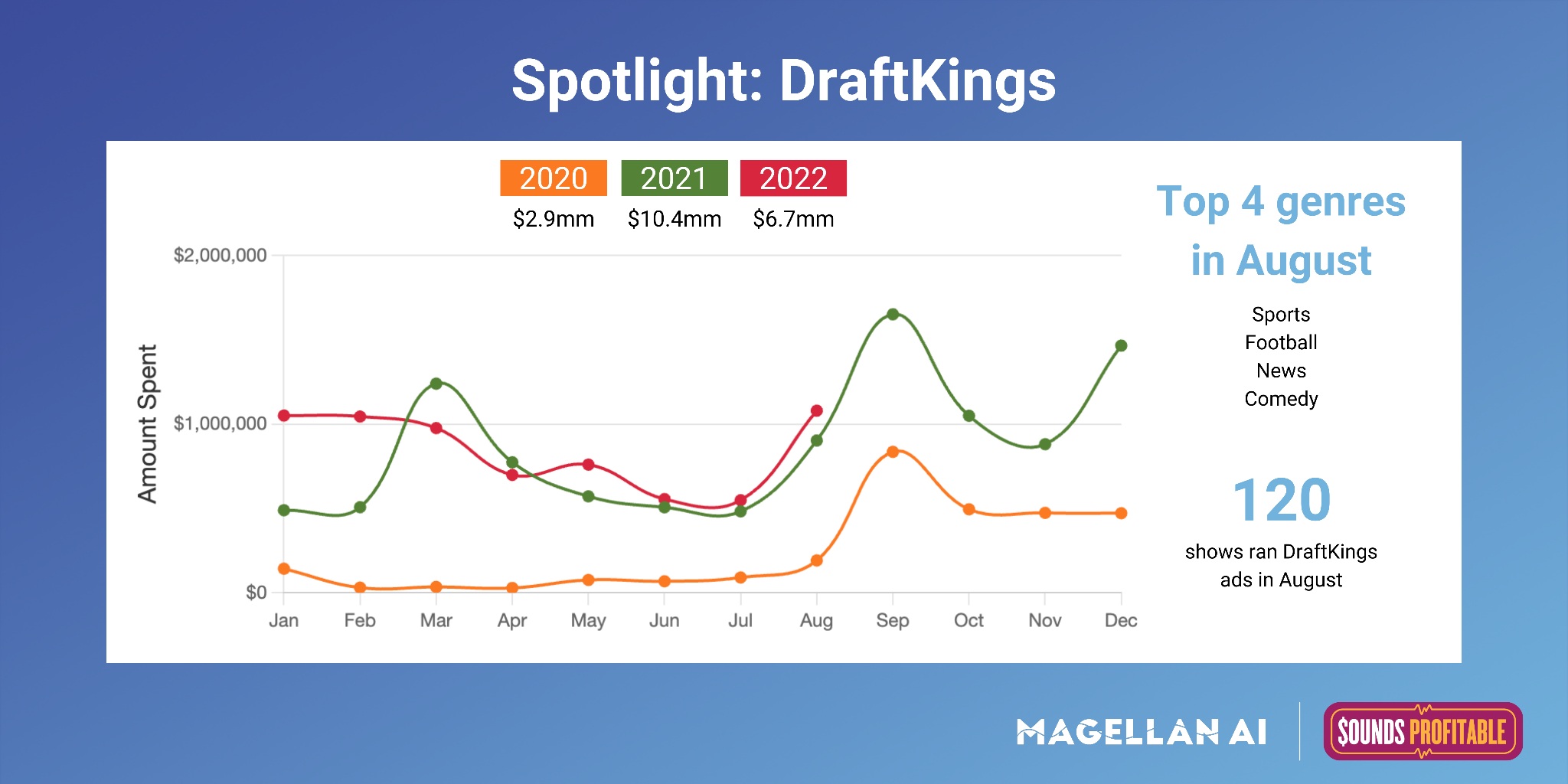
This week we are highlighting DraftKings, a brand that has been advertising heavily on podcasts this year since August. Historically September has been DraftKings biggest month and this year it is shaping up to be its biggest yet.
DraftKings is the largest Fantasy Sports advertisers in the podcast space and has spent close to $20mm since it first started advertising. As of August 2022 DraftKings has spent 60% of its total budget in 2021. This is notable because September and December, the months where DraftKings historically spends the most, are not included in the 2022 total.
Interested in DraftKings total spend in September? [Sign up to join the 15-minute monthly market update on October 20th]
Anatomy of an Ad with ThoughtLeaders

Sponsoring brand: Bombas
Where we caught the ad: Moms Don’t Have Time to Read Books
Who else has sponsored this podcast? Kachava, Fabric Insurance, TalkSpace, Pango Books
Where else has this brand appeared? Humble and Hungry with Natalie Puche, The Allusionist, The Upside with Callie and Jeff, Myths and Legends
Why it works: The only thing booklovers need (aside from books, obviously) are comfy socks so this integration between a book-focused podcast and Bombas, specially designed socks with comfort in mind, is spot-on. The host of the podcast seamlessly jumped into the ad-read by noting, “you may think it’s funny that I am obsessed with my socks but it’s true I only wear Bomba socks…and I was excited to tell my family that they were sponsoring this podcast.” The fact that the host actually likes the brand and its products before getting sponsored makes the promotion much more believable and influential.
New Partners
Sounds Profitable exists thanks to the continued support of our amazing partners. Monthly consulting, free tickets to our quarterly events, partner-only webinars, and access to our 500+ person slack channel are all benefits of partnering Sounds Profitable.
- Supporting Cast is the most seamless and flexible way to sell and deliver podcast subscriptions and audiobooks through any podcast app—trusted by more top networks and shows than any other cross-platform membership service.
- NBM “Next Broadcast Media” is an independent programmatic audio expert with a focus on emerging markets “MENA, SSA, APAC..” They help brands tap into the most extensive, non-fragmented audio inventory across 50+ countries.
Want to learn more about partnership? Hit reply or send us an email!

